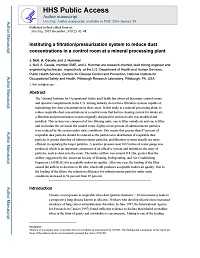Mining Publication: Instituting a Filtration/Pressurization System to Reduce Dust Concentrations in a Control Room at a Mineral Processing Plant
Original creation date: December 2015
The National Institute for Occupational Safety and Health has observed that many control rooms and operator compartments in the U.S. mining industry do not have filtration systems capable of maintaining low dust concentrations in these areas. In this study at a mineral processing plant, to reduce respirable dust concentrations in a control room that had no cleaning system for intake air, a filtration and pressurization system originally designed for enclosed cabs was modified and installed. This system was composed of two filtering units: one to filter outside air and one to filter and recirculate the air inside the control room. Eighty-seven percent of submicrometer particles were reduced by the system under static conditions. This means that greater than 87 percent of respirable dust particles should be reduced as the particle-size distribution of respirable dust particles is greater than that of submicrometer particles, and filtration systems usually are more efficient in capturing the larger particles. A positive pressure near 0.02 inches of water gauge was produced, which is an important component of an effective system and minimizes the entry of particles, such as dust, into the room. The intake airflow was around 118 cfm, greater than the airflow suggested by the American Society of Heating, Refrigerating, and Air-Conditioning Engineers (ASHRAE) for acceptable indoor air quality. After one year, the loading of the filter caused the airflow to decrease to 80 cfm, which still produces acceptable indoor air quality. Due to the loading of the filters, the reduction efficiency for submicrometer particles under static conditions increased to 94 percent from 87 percent.
Authors: JD Noll, AB Cecala, JA Hummer
Peer Reviewed Journal Article - December 2015
NIOSHTIC2 Number: 20047517
Min Eng 2015 Dec; 67(12):42-48
See Also
- Air Cleaning Performance of a New Environmentally Controlled Primary Crusher Operator Booth
- Best Practices for Controlling Respirable Dust in Coal Mines
- Current NIOSH Dust Control Research for Noncoal Surface Mines
- Development of a canopy air curtain to reduce roof bolters’ dust exposure
- Effects of MERV 16 Filters and Routine Work Practices on Enclosed Cabs for Reducing Respirable Dust and DPM Exposures in an Underground Limestone Mine
- Laboratory and Field Evaluation of Dust Collector Bags for Reducing Dust Exposure of Roof Bolter Operators
- Maximizing Air Quality Inside Enclosed Cabs with a Unidirectional Filtration and Pressurization System
- Technology News 463 - Machine-Mounted Continuous Respirable Dust Monitor
- Technology News 509 - A New Method to Clean Dust From Soiled Work Clothes
- Technology News 533 - Minimizing Respirable Dust Exposure in Enclosed Cabs by Maintaining Cab Integrity - TN-No. 533
- Content source: National Institute for Occupational Safety and Health, Mining Program


 ShareCompartir
ShareCompartir
